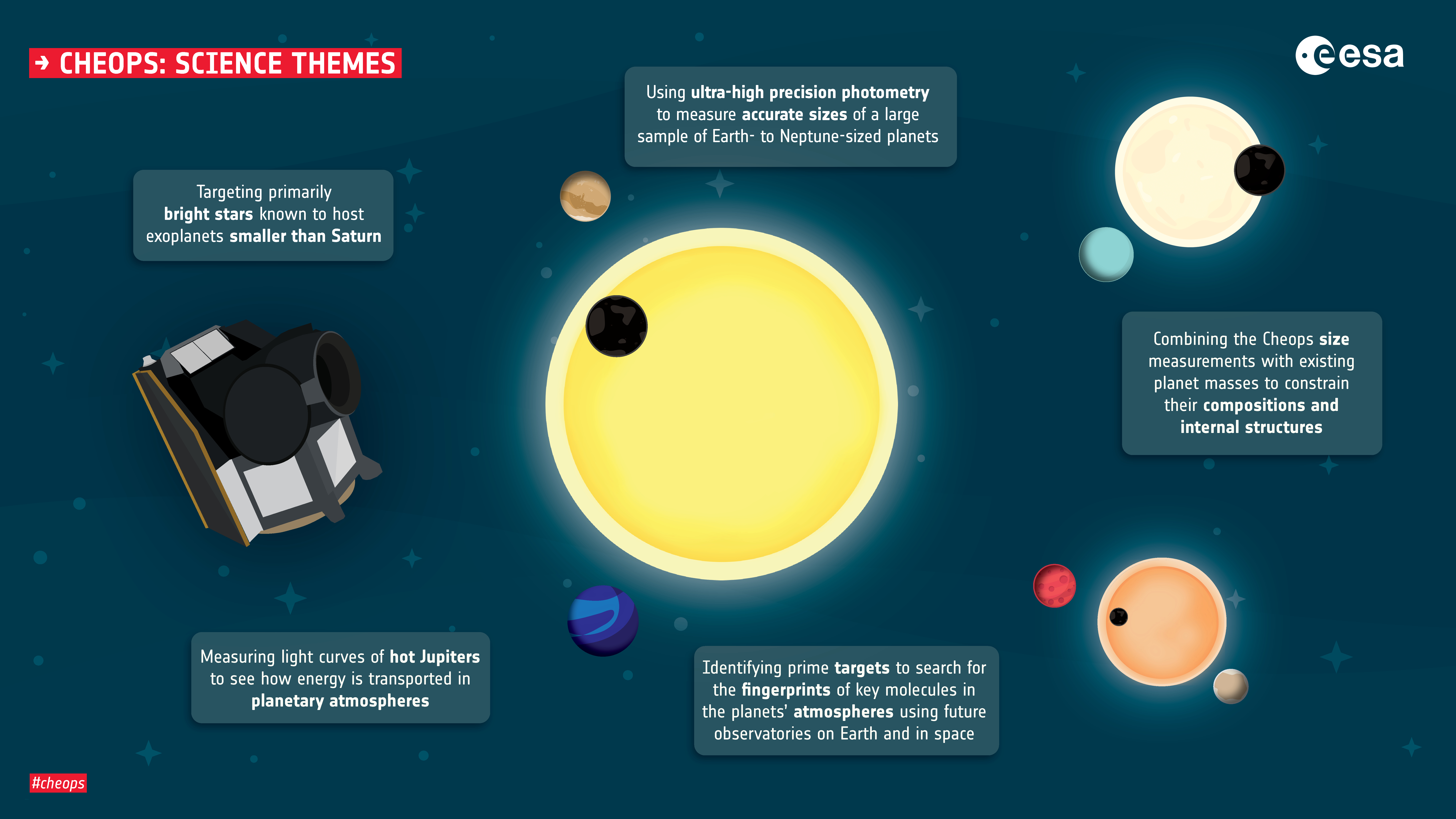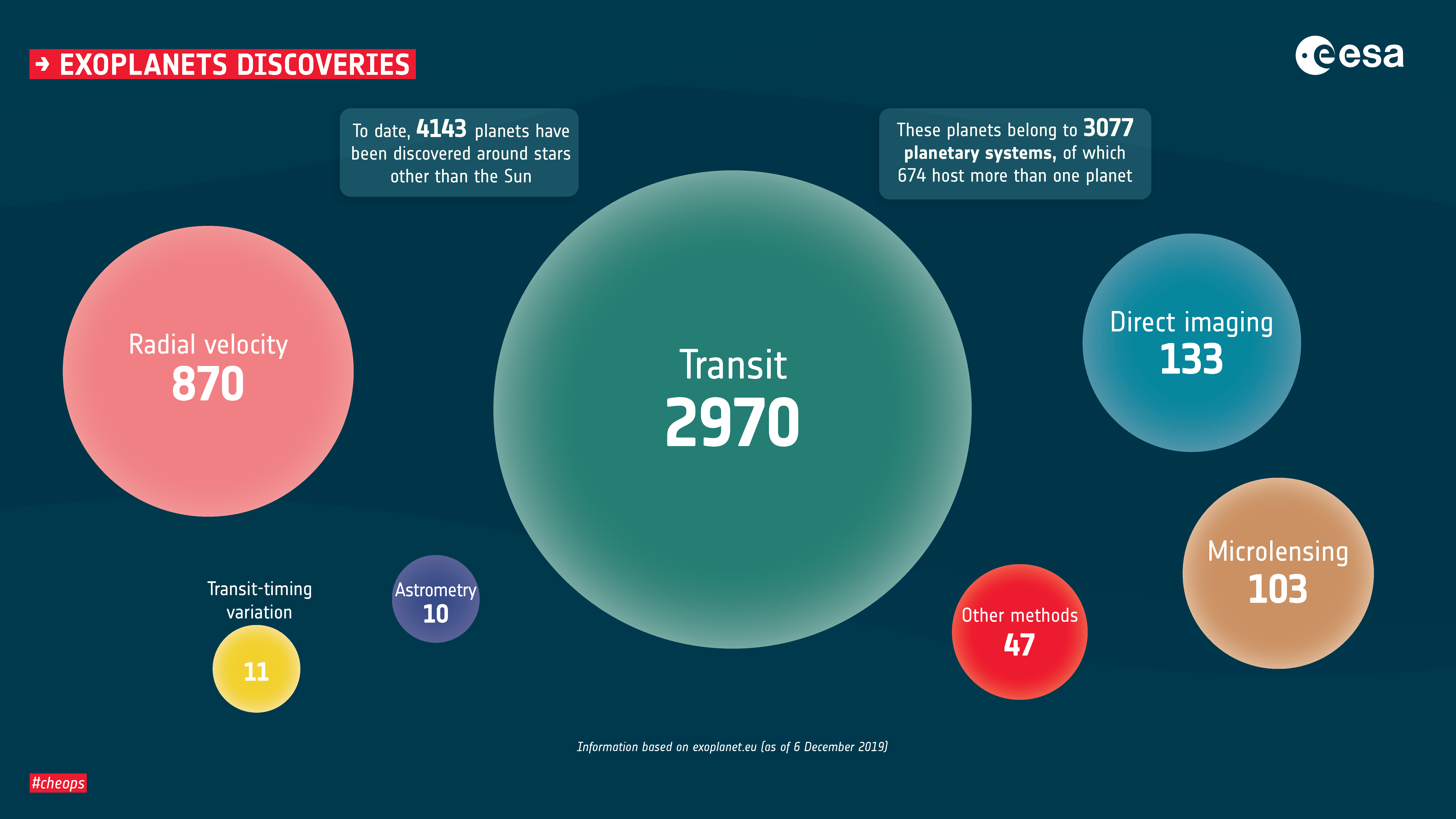Measuring about 1.5 meters in height and a maximum 1.6 meters on its side, Europe's latest space telescope may appear somewhat small. But what it lacks in size, CHEOPS more than compensates for with its mesmerizing ability to peer into distant alien worlds.
The CHaracterising ExOPlanet Satellite (CHEOPS), launched on 18 December, 2019, is the European Space Agency's (ESA) first mission dedicated to the study of known planets outside the solar system, also known as "extrasolar planets," or "exoplanets."
And after a series of testing and manoeuvring, the satellite is now set to embark on a mission of discovery.
CHEOPS will target stars that are hosting planets in the Earth-to-Neptune-size range, yielding accurate and precise measurements of their sizes.
This, combined with data on a planet's mass, will allow scientists to determine its density and enable a first-step characterization. Which, in turn, will provide key insight into the formation and evolution processes of these celestial bodies.
All systems go for CHEOPS
The orbiting observatory beamed back images of its first target in February – a yellow-white star called HD70843, situated around 150 light years away, creating ripples of excitement among scientists.

The telescope deliberately transmits defocused images on to the detector in order to distribute the light from each star over many pixels. /ESA
"This is a defining moment for the mission," says Nicola Rando, ESA project manager for CHEOPS.
"To the engineers and scientists across Europe who have worked and continue to work on CHEOPS, this image represents the culmination of many years of dedication and effort – designing, planning, coordinating and building this new and unique satellite."
The image, however, was blurry – but there's logic behind it.
The 30-centimeter telescope deliberately delivers defocused images on to the detector – a charge-coupled device (CCD) – in order to distribute the light from each star over many pixels.
This makes the measurements of starlight more accurate, as they are much less sensitive to small differences in the response of individual pixels in the CCD and to variations in the telescope pointing.
"The first images that were about to appear on the screen were crucial for us to be able to determine if the telescope's optics had survived the rocket launch in good shape," says Willy Benz, principal investigator of the CHEOPS Mission Consortium from the University of Bern, Switzerland.
"When the first images of a field of stars appeared on the screen, it was immediately clear to everyone that we did indeed have a working telescope."
01:42
The mission
CHEOPS is a small, or S-class project, with the mission operations center based in Torrejon, near Madrid, Spain.
It is a cooperation between ESA and Switzerland, with important contributions from 10 other ESA member states that, together with Switzerland, make up the CHEOPS Mission Consortium.
The University of Bern is one of the nodal institutions. The science operations center is located at the University of Geneva.
Unlike previous exoplanet satellites, such as the French CNES-led CoRoT or NASA's Kepler and Tess missions, CHEOPS is not a "discovery machine" but rather a follow-up mission, focusing on individual stars that are already known to host one or more planets.
Magali Deleuil, a researcher at the Laboratoire d'Astrophysique de Marseille (LAM) explains the rationale behind the initiative.
"The most common exoplanets in our galaxy have sizes between those of Earth and Neptune, with a diversity in their properties and compositions ranging from rocky to gas-dominated envelope, that was not expected. The origin of this diversity is still not well understood, mostly because we lack precise determination of their parameters.
"The issue is that most of these planets are orbiting very faint stars and, as a consequence, most of them have masses not well known to us. By observing planets around bright stars, CHEOPS will change that. It will measure a planet's size with unprecedented precision."

CHEOPS will target stars that are hosting planets in the Earth-to-Neptune-size range, yielding precise measurements of their dimensions. /ESA
Peeping into deep space
The methodology applied to take measurements is no less fascinating.
CHEOPS uses the "transit photometry" technique, whereby the telescope would measure the light curve of a star for periodic dips in brightness as exoplanets pass in front of it.
The size or depth of the dip is related to the relative size of the planet to the star, in fact to the square of the ratio of the size of the planet to the star.
Some of the exoplanets that CHEOPS will focus on in the early stages of the mission include the so-called "Styrofoam world" Kelt-11b; the "lava planet" 55 Cancri-e; and the "evaporating planet" GJ-436b.
Kelt-11b, a puffy gaseous exoplanet, about 30 percent larger in size than Jupiter and orbiting close to the star HD93396, was the first to be observed by CHEOPS in March during its in-orbit commissioning.
HD93396 is a "subgiant yellow star" that is located 320 light years away, slightly cooler and three times larger than the Sun.
The satellite was successful in determining the planet's diameter to be 181,600 kilometers, with an uncertainty of just under 4,300 kilometers.
CHEOPS is expected to train its eye on hundreds of such known planets in the next three-and-a-half years, enabling scientists to gather a treasure trove of information about the far-flung objects.
Barbara Negri, head of the Italian Space Agency's (ASI) observation and exploration of the universe unit, emphasizes the ancillary science that can be conducted during the course of the mission.

CHEOPS is going to pave the way for a new crop of spacecraft in the next decade. /ESA
"For some planets it could be possible to trace a 'phase curve,' where the transiting planet contributes in changing the brightness of the star while moving around it, providing clues on the nature of its atmosphere."
She adds: "Because of its high precision, CHEOPS may be able to detect other smaller planets in the star system that could not be detected before; moons and rings are other features that the telescope may be able to trace."
A trailblazer telescope
The quest to discover exoplanets does not end with CHEOPS.
The project is going to pave the way for a new crop of spacecraft in the next decade, including in the PLAnetary Transits and Oscillations of stars (PLATO) and Atmospheric Remote-sensing Infrared Exoplanet Large-survey (ARIEL) missions.
An M, or medium-class mission, PLATO will employ transit photometry to search for rocky planets in orbits in the so-called habitable zone around Sun-like stars.
It will also study the seismic activity of the host stars to characterize them – to determine their sizes, their masses and also their ages.
ARIEL, again a M-class mission, will have a slightly different agenda. It will seek to analyze the atmosphere of the planets, conducting a chemical census of sorts to improve our understanding of exoplanets, both as separate entities and as populations.
**Remember to sign up to **
Global Business Daily here
** to get our top headlines direct to your inbox every weekday.**
 简体中文
简体中文

